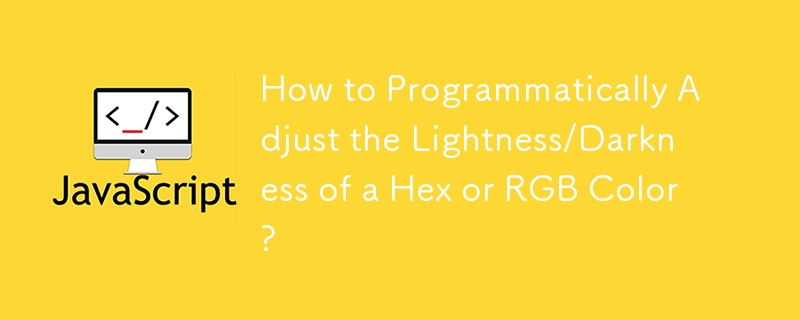

How to Programmatically Adjust the Lightness/Darkness of a Hex or RGB Color
This function, pSBC, provides a versatile way to adjust the lightness/darkness or blend two colors with ease. Here's a breakdown of how it works:
Features:
Usage:
To use pSBC, pass in the following parameters:
Code:
<code class="javascript">const pSBC = (p, c0, c1, l) => {
// Handle parameter defaults
l = typeof l !== "undefined" ? l : false;
// Error checking
if (
typeof p !== "number" ||
p < 0 ||
p > 1 ||
typeof c0 !== "string" ||
(c0[0] !== "r" && c0[0] !== "#") ||
(c1 && !a)
)
return null;
// Determine color format and extract channel values
let r, g, b, P, f, t, h, i = parseInt, m = Math.round, a = typeof c1 == "string";
if (typeof p !== "number" || p < 0 || p > 1 || typeof c0 !== "string" || (c0[0] !== "r" && c0[0] !== "#") || (c1 && !a)) return null;
if (!this.pSBCr) this.pSBCr = (d) => {
let n = d.length, x = {};
if (n > 9) {
[r, g, b, a] = d = d.split(",");
n = d.length;
if (n < 3 || n > 4) return null;
x.r = i(r[3] == "a" ? r.slice(5) : r.slice(4)), x.g = i(g), x.b = i(b), x.a = a ? parseFloat(a) : -1
} else {
if (n == 8 || n == 6 || n < 4) return null;
if (n < 6) d = "#" + d[1] + d[1] + d[2] + d[2] + d[3] + d[3] + (n > 4 ? d[4] + d[4] : "");
d = i(d.slice(1), 16);
if (n == 9 || n == 5) x.r = d >> 24 & 255, x.g = d >> 16 & 255, x.b = d >> 8 & 255, x.a = m((d & 255) / 0.255) / 1000;
else x.r = d >> 16, x.g = d >> 8 & 255, x.b = d & 255, x.a = -1
}
return x
};
h = c0.length > 9, h = a ? c1.length > 9 ? true : c1 == "c" ? !h : false : h, f = this.pSBCr(c0), P = p < 0, t = c1 && c1 != "c" ? this.pSBCr(c1) : P ? { r: 0, g: 0, b: 0, a: -1 } : { r: 255, g: 255, b: 255, a: -1 }, p = P ? p * -1 : p, P = 1-p;
if (!f || !t) return null;
if (l) r = m(P * f.r + p * t.r), g = m(P * f.g + p * t.g), b = m(P * f.b + p * t.b);
else r = m((P * f.r ** 2 + p * t.r ** 2) ** 0.5), g = m((P * f.g ** 2 + p * t.g ** 2) ** 0.5), b = m((P * f.b ** 2 + p * t.b ** 2) ** 0.5);
a = f.a, t = t.a, f = a >= 0 || t >= 0, a = f ? a < 0 ? t : t < 0 ? a : a * P + t * p : 0;
if (h) return "rgb" + (f ? "a(" : "(") + r + "," + g + "," + b + (f ? "," + m(a * 1000) / 1000 : "") + ")";
else return "#" + (4294967296 + r * 16777216 + g * 65536 + b * 256 + (f ? m(a * 255) : 0)).toString(16).slice(1, f ? undefined : -2)
};</code>Examples:
Lightening/Darkening:
Blending:
Hex/RGB Conversion:
Note: For best performance, use the provided micro functions if error checking and other features are not required. They are tailored for specific operations and provide maximum speed and size efficiency.
The above is the detailed content of How to Programmatically Adjust the Lightness/Darkness of a Hex or RGB Color?. For more information, please follow other related articles on the PHP Chinese website!
 Digital currency quantitative trading platform
Digital currency quantitative trading platform
 Regular expression space
Regular expression space
 What is the impact of closing port 445?
What is the impact of closing port 445?
 Firefox browser plug-in summary
Firefox browser plug-in summary
 There are several types of php arrays
There are several types of php arrays
 How to retrieve Douyin flames after they are gone?
How to retrieve Douyin flames after they are gone?
 Why does win10 activation fail?
Why does win10 activation fail?
 Advantages of spring boot framework
Advantages of spring boot framework




